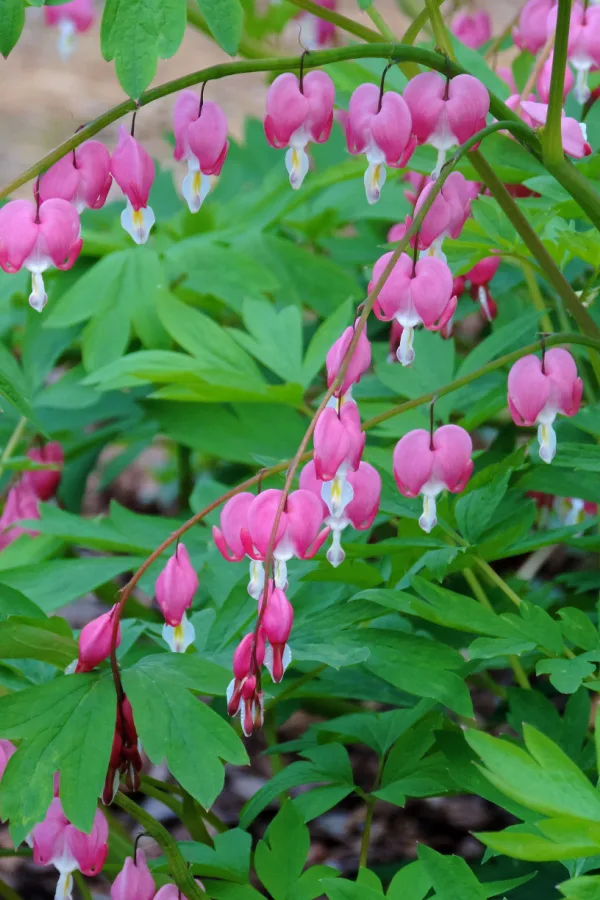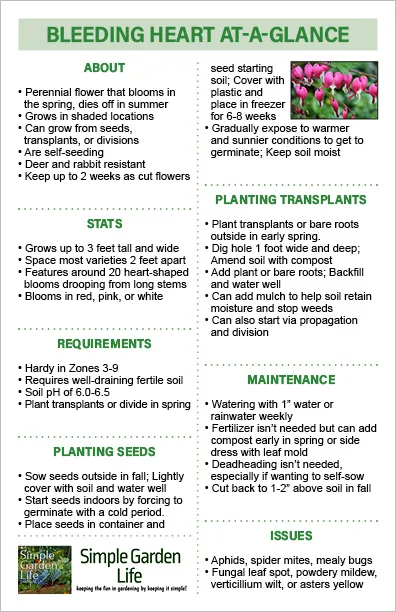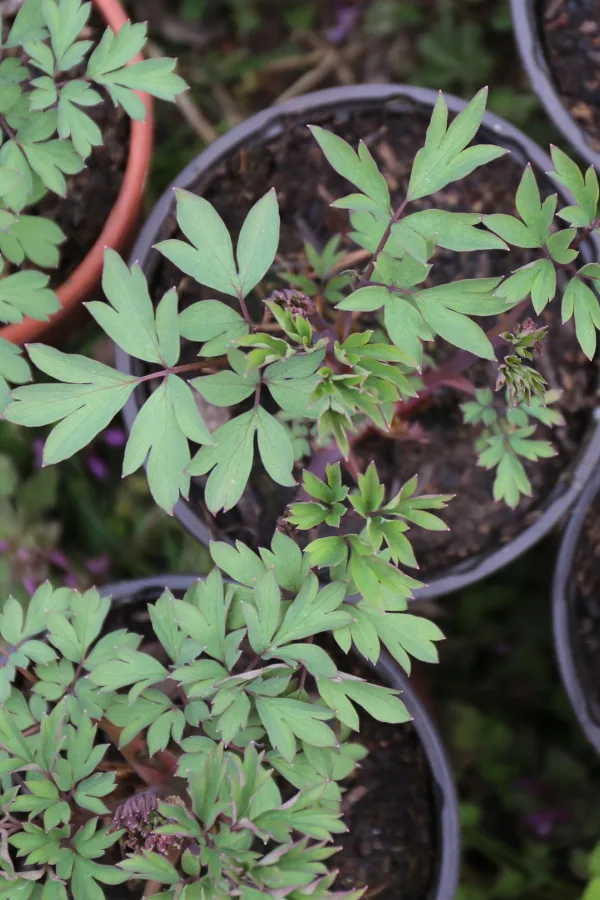If you are looking to grow an eye-catching perennial in your garden space, bleeding heart is the perfect plant for the job!
The stunningly beautiful perennial gets it name from its puffy, heart-shaped blooms that appear at first glance to almost weep from below the flower. In reality, the bloom gets its “bleeding” look from a contrasting white petal that drops from below the heart shaped flower.
The look is unique for sure, especially when the plants are covered in full with blooms. And the plant can be even more impressive in the landscape the larger it grows. At maturity, bleeding hearts can grow up to three feet tall and wide, featuring loads of showy blooms in shades of red, white, and pink.

While some consider this to be an old-fashioned flower, its popularity has risen in part to the fact that bleeding hearts are very easy to grow and maintain. In fact, as you will see below, as long as they receive partial shade and a bit of basic care, bleeding hearts can reward you years of unique and eye-catching blooms.
Considered hardy in growing Zones 3 through 9, it makes a great choice for those looking to add some spring color to spaces that sun-loving plants often struggle to thrive in.
How To Plant, Grow, And Maintain Bleeding Hearts
Bleeding hearts are a very simple perennial to care for. If you start with the right growing location and provide them with a bit of water, they will self-sustain for many years. Since they are also self-seeding, they will continue to push out new plants as the old ones die off.
Planting Bleeding Hearts
Starting Seeds Indoors
Bleeding heart plants can be started via seed indoors or sown directly in the soil outdoors. Most gardeners opt to start their seeds outdoors, as it can take a bit more effort to grow indoor seedlings. But as you will see below, there are good reasons to do it both ways.

When starting indoors, you will need to force the seeds into germination by giving them a chilling period when planting. Begin by planting seeds in a container filled with seed-starting soil. Place the container in a plastic bag or cover it completely with plastic wrap.
Next, place the bag in your freezer for about six to eight weeks. After this time period, gradually reintroduce the container to warmer and sunnier conditions. The seeds should begin to germinate as the soil warms. Water to keep the soil evenly moist but not saturated.
For sowing seeds directly into the garden, it is best to do so in the fall. So if you are wanting to try your hand at growing the plant this year – you will either have to purchase transplants, or seed with the chilling method.
When planting fall seeds, cast seeds and cover lightly with soil. Water lightly and continue to keep the soil moist until it begins to freeze. A light layer of mulch over the seeds for winter will help protect them as well. In the spring, when the soil begins to warm up, the seeds should start to germinate.
Planting Transplants
You can also grow bleeding hearts by using nursery transplants or bare-root plants. Most local nurseries will start to carry bleeding heart transplants early in the spring. Those can be planted almost any time the weather allows.

For bare-root plants, aim for planting in early spring. Be sure to soak the roots in water for an hour or so prior to planting. Whichever method you choose, pick a growing location that has partial shade to full shade. As for soil, bleeding hearts will grow well in most soils, but do best if the soil is slightly acidic.
Amend your planting area with compost to add organic matter and nutrients and to help improve soil drainage. Place the transplant or bare root into the holes spaced about two feet apart and back fill gently. Tamp down the soil and water plants well. Affiliate Link : Valentine Bleeding Heart Bare Root Plant
Last but not least, you can also create new plants by dividing existing ones. Bleeding heart plants can be successfully divided in the spring or fall. Keep in mind that bleeding heart plants are also self-seeding, so you often don’t need to replant once you have done so once.
Long-Term Care – How To Grow and Maintain Bleeding Hearts
Mulching
Mulch is quite beneficial in helping bleeding hearts both establish and maintain good growing habits. Not only will mulch help the soil retain moisture, it also regulates the soil temperature. Best of all, mulch helps prevent unwanted and competing weeds from growing.
Fertilizing
Bleeding hearts are not heavy feeders as they grow, so they do not require additional fertilizers after planting. A good dose of compost early each spring will help to provide all the nutrients bleeding hearts need and will also help kick-start blooming.

Deadheading & Pruning
You can help your bleeding heart plants even more by deadheading spent blooms. This will help plants to focus their resources on new blooms and can help to prolong blooming. Do not deadhead blooms if you are wanting plants to self-seed. See: How To Deadhead For Healthier Plants & More Blooms!
After the plants start to die off and go dormant in the summer, it is a good idea to cut back the dead foliage to about an inch or two above the soil line. At this point, it is also best to add a few inches of mulch to the top of the plant. Beyond this, no further pruning is necessary.
Pests & Issues – How To Plant & Grow Bleeding Heart
Another great feature of bleeding hearts is that they are typically left alone by pests and critters. In fact, they are actually deer and rabbit resistant. You may encounter some typical pest issues that you can find on almost any plant like aphids, spider mites, or mealy bugs.

Cuttings
Bleeding hearts are often beloved as cut or pressed flowers with their unique flowering style. The good news is that both are easy to do! For cut flowers, cut the entire stem when taking cuttings and place it in a vase of water. Do not submerge the blooms, and they should last for up to two weeks.
If using blooms for pressed flowers, harvest dry blooms early in the morning. Place the flower between two sheets of wax paper and press between two heavy books. Allow the flower to dry out undisturbed for a couple of weeks.
They are actually quite beautiful and just one more reason to grow bleeding heart and have this unique and eye-catching perennial in your garden space this year and beyond!
Follow Our Facebook Page For Even More Great Tips! Simple Garden Life Facebook Page
Simple Garden Life is a website dedicated to keeping gardening fun, simple and enjoyable! We publish two new articles each week along with a new garden podcast episode every two weeks. This article may contain affiliate links.
Feel free to download, print out, or save our Bleeding Hearts At-A-Glance sheet. It is sized for half letter printing but can be scaled if needed.
